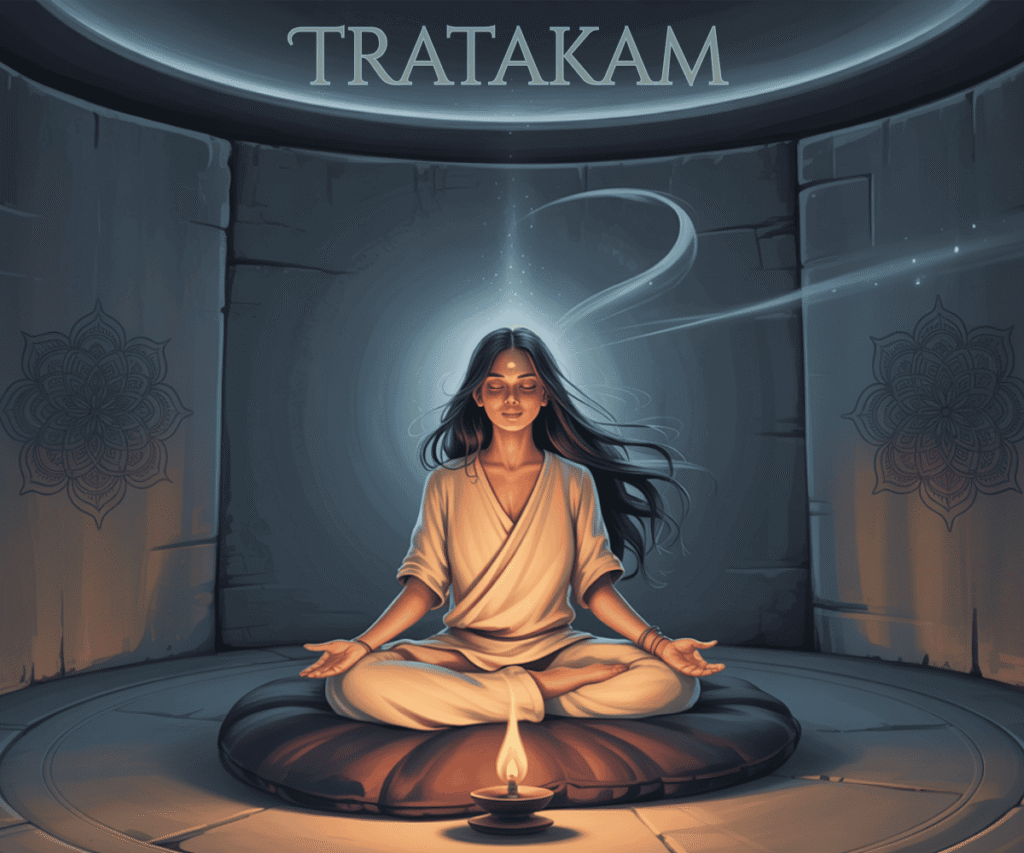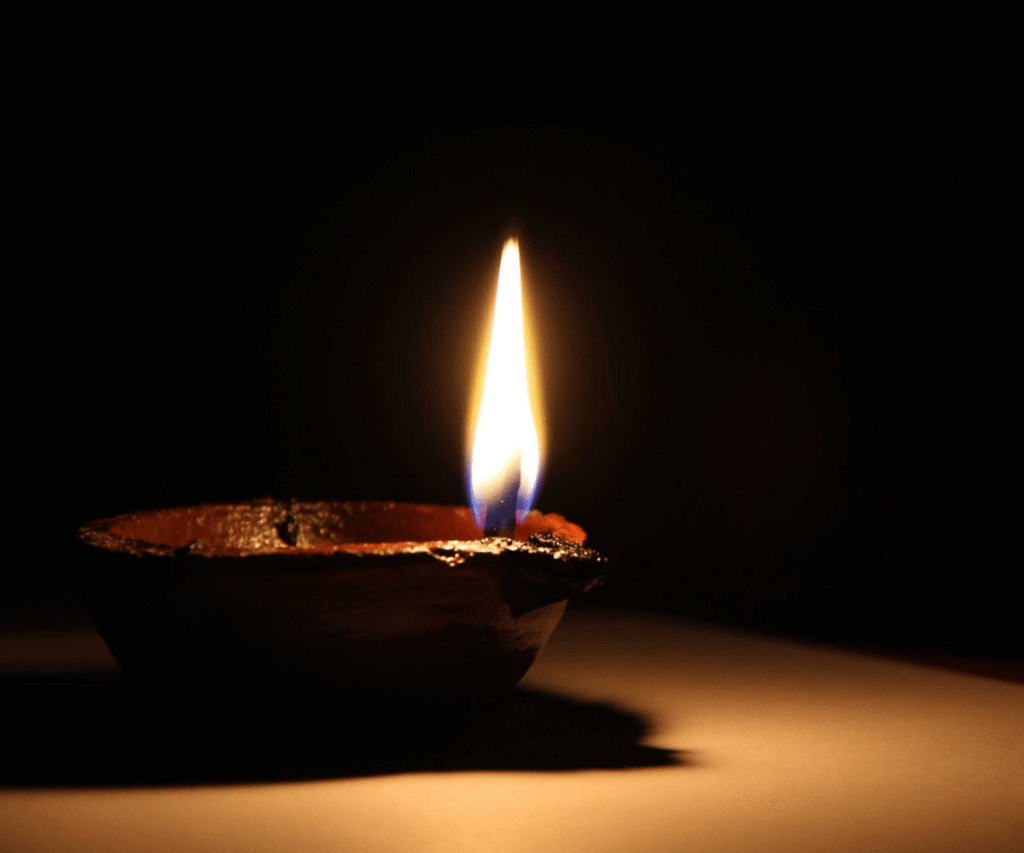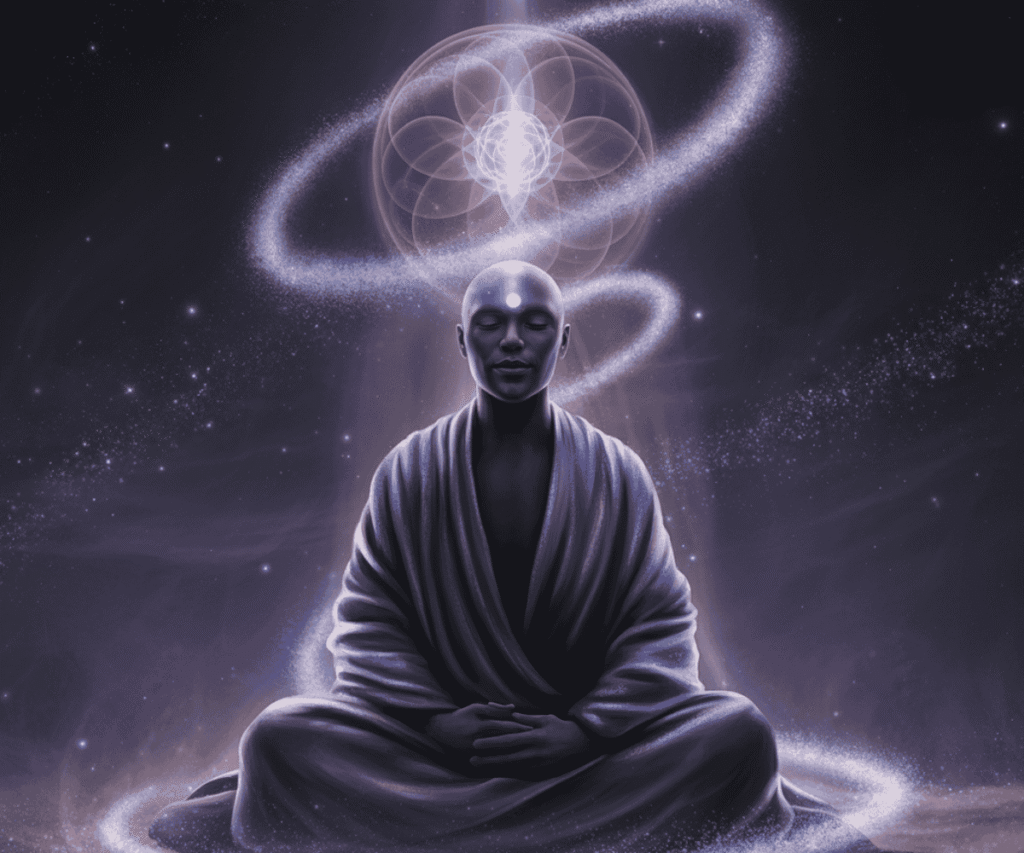Trataka Meditation:
Ancient Candle-Gazing Ritual for Focus and Inner Vision

This post contains affiliate links. If you choose to make a purchase, I may earn a small commission at no extra cost to you. I only recommend products I personally use and trust.
“Through endless corridors of shadow we walked,
the night carrying whispers of forgotten truths.
Then a single flame appeared, steady and clear,
and in its glow the path of wisdom was revealed.“
— Rishi Pranadeva
The room is still and dim, the air carrying the faint scent of warm ghee. Before you, a single flame flickers, steady and golden, casting soft shadows on the walls. Your gaze rests on its center. At first, thoughts wander, but the longer you watch, the quieter the mind becomes. The flame feels alive, as if it holds a secret only the patient can hear. This is trataka meditation: a candle‑gazing ritual passed down through yogic tradition, said to cleanse the mind, sharpen the senses, and awaken the inner vision.
In this guide, we’ll explore where this practice comes from, why it has been treasured by yogis for centuries, and how you can bring its focus‑building and spirit‑nourishing effects into your own life. You’ll learn the classical roots found in ancient texts, the mystical associations with the third eye, the modern research on its benefits, and a step‑by‑step method for practicing it yourself.

What Is Trataka Meditation?
The Sanskrit word trāṭaka means “to gaze” or “to look steadily.” In the yogic tradition, trataka meditation is the art of fixing your gaze on a single point without blinking, until the eyes naturally water. It is one of the shatkarmas, the six cleansing techniques described in classical Hatha Yoga, and is used both to purify the body and steady the mind.
The Hatha Yoga Pradipika, a 15th‑century manual of yogic practice, defines it as sitting calmly and “gazing intently at a small point until tears flow,” a method said to cleanse the visual system, remove mental sluggishness, and prepare the mind for deep concentration. In the lineage of yoga, trataka is more than an exercise for the eyes — it is a bridge between dharana (one‑pointed focus) and dhyana (meditation).
Though the flame from an oil lamp or candle is the most common object of focus, yogis have long practiced trataka using symbols, sacred diagrams, the moon, or even the rising sun. In each case, the outer object serves a singular purpose: to still the eyes so the mind can turn inward, revealing what the sages called the “inner light.”
Classical Roots and Mystical Alignment
Trataka’s place in yoga is as old as the medieval manuals that codified the practice. In the Hatha Yoga Pradipika (Verse 2.31), the instruction is simple: gaze at a small point without blinking until the eyes fill with tears. The text credits this with removing eye disease, fatigue, and mental dullness — the kind of purification a yogi needs before moving into more subtle practices. The Gheranda Samhita echoes this, adding that trataka sharpens the inner vision and can awaken extraordinary perception.
In yogic physiology, trataka is closely linked to the ajna chakra — the “third eye” located between the eyebrows. This is considered the seat of intuition, inner guidance, and higher perception. By gazing steadily at the flame and then holding its after‑image in the mind’s eye, a practitioner is said to activate this center, awakening what the scriptures call divya drishti, or “divine sight.”
Some tantric and Vedantic sources speak of trataka as a doorway into the inner world — the flame representing the jyoti, the eternal light within. In these traditions, the act of gazing is not just physical but symbolic: the outer flame is a reflection of the light of consciousness itself. Over time, the distinction between seeing with the eyes and “seeing” with the mind begins to blur, and moments of deep clarity can arise.
While modern practitioners may interpret these claims metaphorically, the classical intent was clear that trataka was a tool to polish the lens of perception, both outer and inner, until it could reflect truth without distortion.
Modern Benefits:
Where Science Meets the Flame
While the old yogis praised trataka for awakening inner vision, modern researchers are beginning to uncover measurable effects on the mind and body.
Sharper focus and memory
Controlled studies have found that a short daily practice of trataka can improve working memory, spatial recall, and attention span. In one trial, participants who performed trataka outperformed those doing ordinary eye exercises in tests of focus and mental flexibility. By narrowing the senses to a single point, the brain’s ability to filter distractions seems to strengthen.
Relief for tired eyes
Many people today spend hours staring at screens, leading to dryness, strain, and fatigue. Trataka stimulates natural tearing, which lubricates the eyes, and shifts the visual focus to a gentle, steady light. Some studies have even noted positive changes in eye pressure and relief from headaches. While it’s not a cure for vision problems, it can be a simple, screen‑free workout for the eyes.
Stress reduction and emotional calm
The act of sustained, unblinking focus has a settling effect on the nervous system. Practitioners often report a noticeable drop in mental chatter within minutes. One study on adolescents found a significant reduction in anxiety after just ten days of practice. When done in the evening, candle gazing can quiet the mind enough to prepare for restful sleep.
Greater clarity and self‑awareness
Even without accepting the mystical claims of the third eye, it’s easy to see how trataka could sharpen inner perception. A mind that learns to hold attention on one point becomes less reactive and more deliberate. Over time, this can lead to more insight into one’s thoughts, moods, and habits.
How to Practice Trataka Meditation
One of the beauties of trataka meditation is its simplicity. You need little more than a flame, a quiet space, and a few minutes of focused presence.
1. Prepare your space
Choose a quiet, dimly lit room free from drafts so the flame remains steady. Place a candle or traditional oil lamp about two to three feet in front of you, with the flame at eye level. Many practitioners prefer a oil lamp because it produces a steady, unwavering glow.
Recommended Tool for Your Trataka Practice: For the most still flame and traditional feel, I recommend this oil lamp with cotton wicks and using sesame oil or ghee. Its steady light is perfect for extended gazing sessions. If you prefer a simpler option, a candle works beautifully too.
2. Settle your body and mind
Sit comfortably with a straight spine, either cross‑legged on the floor or on a chair. A supportive yoga mat can make all the difference during longer sessions — I personally recommend Manduka mats for their durability and grounding feel. Rest your hands on your knees or in your lap. Before beginning, close your eyes and take a few slow, deep breaths to release tension. A calming breath technique like Nadi Shodhana can help balance your mind and prepare you for deeper focus.
3. Begin external gazing
Open your eyes and fix them gently on the flame’s tip, where the light is most steady. Keep your gaze soft but steady, avoiding any strain. Minimize blinking, but do not force yourself to keep the eyes open if they become painful.
4. Move to internal gazing
When your eyes begin to water or feel tired, gently close them. You will likely see an after‑image of the flame. Bring your awareness to the space between your eyebrows (the ajna chakra) and hold the image there for as long as it remains.
5. Repeat and finish
Alternate between external and internal gazing for a total of two to five minutes at first. With time, you can extend the practice to ten minutes. End by resting quietly with your eyes closed, allowing the calm and clarity to settle in.
Safety tips
Avoid practicing if you have serious eye conditions without medical guidance. Epileptics should not gaze at a flickering flame. Never stare at the midday sun, and always keep fire safety in mind. If you feel strong eye strain, blink or take a break. Trataka is meant to be gentle, not forced.
Variations and Common Mistakes to Avoid
Common mistakes to avoid:
- Overstraining the eyes — Many beginners try to force themselves not to blink, leading to redness and discomfort. A steady gaze is the goal, but comfort should come first. Over time, your ability to gaze without blinking will grow naturally.
- Tensing the face — Furrowed brows or squinting create tension that disrupts the meditative state. Keep your facial muscles relaxed, as if gazing at a distant horizon.
- Pushing sessions too long — Starting with ten minutes can cause fatigue. Begin with two to five minutes and gradually increase your time as your eyes and mind adapt.
- Unsteady flame — A candle that flickers constantly makes concentration harder. Protect your flame from drafts, or use a ghee lamp for a more constant light.
- Forgetting to breathe — Shallow or held breath can create restlessness. Let your breathing remain smooth and natural throughout the practice.
Variations to explore:
- Dot gazing (bindu trataka) — Instead of a flame, focus on a black dot on a white surface. This is a gentler option for those with light sensitivity.
- Yantra or image gazing — Choose a sacred symbol, diagram, or deity image. The meaning behind the object can add a devotional element to your practice.
- Mirror trataka — Gaze into your own eyes in a mirror. This variation can be intense, offering deep self‑reflection.
- Moon or star gazing — On clear nights, a steady star or the full moon can be your focus. These forms of trataka connect you with nature’s rhythms.
Each variation follows the same principle: hold your gaze steady, let the mind quiet, and eventually turn the focus inward.

Spirituality Meets Science
For the yogis who preserved this practice, trataka was never just an exercise for the eyes. It was a key to awakening divya drishti — the “divine sight” of inner knowing. In their view, the candle’s glow mirrored the light of consciousness, and by holding the gaze steady, one could still the mind long enough for that inner light to shine through.
Modern science approaches the subject differently, but its findings complement the tradition. Clinical studies confirm improvements in attention, working memory, and mental calm. The meditative focus lowers physiological stress markers and can improve sleep quality. Even if science cannot measure intuition or spiritual awakening, it can recognize that a mind trained in single‑pointed concentration is more resilient, clear, and present.
The overlap between the two perspectives is where trataka’s enduring value lies. A yogi might describe it as opening the third eye; a neuroscientist might say it’s refining neural pathways for sustained attention. Either way, the result is a mind that sees more clearly.
Approach it as an experiment. Practice with patience, observe your own experience, and let the benefits reveal themselves in both subtle and tangible ways.
Explore More
Trataka meditation shines when the mind is already calm and balanced. A powerful way to prepare for it is Nadi Shodhana, the alternate‑nostril breathing technique that purifies the body’s energy channels and steadies attention before you begin gazing.
If you want a structured path through these timeless practices, download our free Classical Pranayama Blueprint — a step‑by‑step guide to foundational breathing, cleansing, and meditative techniques from the yogic tradition. It’s designed to help you integrate rituals like trataka into a complete practice that builds clarity, steadiness, and inner strength over time.
